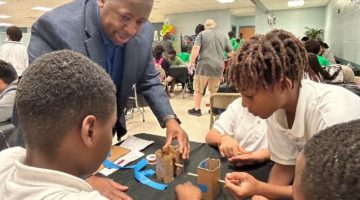 Special to South Florida Times
Special to South Florida Times
OPA-LOCKA — The crime- and drug-ridden Magnolia North neighborhood known as The Triangle is undergoing a long-awaited transformation.
The Opa-locka Community Development Corporation (OLCDC) received a $20 million Neighborhood Stabilization Program grant from the U.S. Department of Housing and Urban Development, which, in part, will go towards restoring the area.
The OLCDC has purchased three apartment complexes on Lincoln Avenue and one on Duval Street. The four properties, which house 58 apartments, are earmarked for redevelopment starting in January, to be completed by the end of 2012.
The contract was awarded to E.L.C.I. Construction Group Inc.
“A lot will happen over the next 12 months,” Willie Logan, OLCDC president and CEO said during a groundbreaking ceremony on Dec. 7. “This project is about redevelopment, rebuilding our neighborhood, turning it into something we are proud of.”
In addition, 20 new single-family homes will be constructed in partnership with Habitat for Humanity.
Three parks along Duval Street will also be built, Logan said. A kiddie park will be built at the north end of the street and a teen park with a basketball court at the southern end. A children’s park that will include a multi-use field for sports will be located in the middle.
“Other recreational areas will be scattered throughout Magnolia North,” said Logan, a former Opa-locka mayor and state legislator.
Opa-locka Mayor Myra Taylor couldn’t agree more. “It’s time we got this forgotten neighborhood up and going,” she said. “The Triangle is no (more). It’s now Magnolia North and we’re all excited to see this project started.”
The neighborhood, which is bordered by Northwest 151st Street, Northwest 22nd Avenue and Ali Baba Avenue, has a storied history. In the 1950s, it was a safe place where children could play outside. But over the years it became overrun by drugs and crime and was named one of the most dangerous neighborhoods in Miami-Dade County.
In the late 1980s, eight metal barriers were permanently installed on the streets that had the effect of controlling entry and egress. The barriers are set on small patches of grass and block all but three streets in and out of Magnolia North.
Those barriers will be replaced with public art works, Logan said.
The 4.2-square-mile city has also been awarded $624,479 in grant money by HUD, Congresswoman Frederica Wilson, D-Fla., announced earlier this month.
Those funds, Wilson said, will go directly to the OLCDC for its Opa-locka Vision 20/20 program, an initiative to make the city more livable, competitive and sustainable.
Wilson said the federal government “tries to make communities more livable, competitive and more sustainable, especially for people who are suffering in the urban core of the nation. So this is really about developing the city and making it a better place for its residents.”
The grant will allow Opa-locka to create a citywide comprehensive plan that includes new code enforcement and zoning ordinances and new design standards; acquire one parcel of property; and develop housing, economic activities and transportation strategies, according to Logan.
“The idea is that this grant will give the city of Opa-locka tools to better plan for both redevelopment and future development,” Logan said.
The OLCDC has identified for upgrade buildings at the five intersections of the city where there are two major streets — Ali Baba Avenue and Opa-locka Boulevard — and the intersections where Northwest 22nd and 27th avenues cross the two major streets.
“We are looking at properties that currently have buildings on it that are operating viable businesses employing people,” said Logan. “Many can undergo aesthetic changes that will make people think differently about the city when they drive through.”
It’s a short-term fix to a long-term problem that will take more effort in terms of making a fundamental difference in the community, Logan said.
The project will also kick off at the beginning of 2012, Logan said, and the CDC will start using the funds in January.
Fillmore Reed reminisces about Magnolia North as “a place we used to play safely outside all summer long,” adding, “But those days are long gone and I was happy to see my kids move because I feared for my grandchildren growing up here.”
Reed, 67, who said his family moved to the neighborhood when he was about 10, welcomes the CDC’s plans. “It sounds like this construction deal will bring it back to those days, but better. It’s surely long overdue.”
Cynthia Roby may be reached at CynthiaRoby@bellsouth.net
Photo: Willie Logan












No Comment